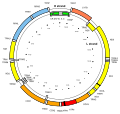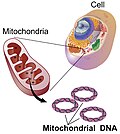The vertebrate mitochondrial code (translation table 2) is the genetic code found in the mitochondria of all vertebrata. AGA and AGG were thought to have...
9 KB (571 words) - 01:42, 23 October 2024
different genetic codes. When translating from genome to protein, the use of the correct genetic code is essential. The mitochondrial codes are the relatively...
85 KB (615 words) - 01:24, 23 October 2024
or Met (M)-Asn (N), respectively (when translating with the vertebrate mitochondrial code). When DNA is double-stranded, six possible reading frames are...
73 KB (8,048 words) - 16:22, 21 November 2024
the creation of mitochondrial DNA haplogroups to study population genetics. Eighty percent of mitochondrial DNA codes for mitochondrial RNA, and therefore...
38 KB (4,014 words) - 00:17, 9 August 2024
Mitochondrion (redirect from Mitochondrial membrane)
protein-coding regions, tRNAs are present. Mitochondrial tRNA genes have different sequences from the nuclear tRNAs, but lookalikes of mitochondrial tRNAs...
167 KB (18,357 words) - 17:01, 19 November 2024
569 base pairs and encodes 13 proteins. As in other vertebrates, the human mitochondrial genetic code differs slightly from nuclear DNA. Since animal mtDNA...
91 KB (10,029 words) - 15:00, 25 November 2024
Translation (biology) (section Genetic code)
The standard code The vertebrate mitochondrial code The yeast mitochondrial code The mold, protozoan, and coelenterate mitochondrial code and the mycoplasma/spiroplasma...
35 KB (4,027 words) - 04:51, 28 October 2024
vertebrate mitochondrial code, Drosophila mitochondrial code, and yeast mitochondrial code. Users may add, remove, or edit any genetic code table. In addition...
33 KB (3,467 words) - 01:56, 11 June 2024
ribosome and can be translated into amino acids (AA) under the vertebrate mitochondrial code: |Start|AAC GAA AAT CTG TTC GCT TCA ... |Start|123 123 123 123...
27 KB (2,642 words) - 03:35, 14 August 2024
The invertebrate mitochondrial code (translation table 5) is a genetic code used by the mitochondrial genome of invertebrates. Mitochondria contain their...
10 KB (925 words) - 07:39, 28 October 2024
400 (31.75%) possible adjacent amino acid combinations in the vertebrate mitochondrial code creates an off-frame stop codon. This suggests that substitutions...
7 KB (817 words) - 10:27, 1 December 2023
have been found in the mitochondrial genomes of vertebrates, Scenedesmus obliquus, and Thraustochytrium. The nuclear genetic code is flexible as illustrated...
30 KB (2,821 words) - 22:41, 9 November 2024
The ascidian mitochondrial code (translation table 13) is a genetic code found in the mitochondria of Ascidia. AAs = FFLLSSSSYY**CCWWLLLLPPPPHHQQR...
6 KB (510 words) - 23:29, 23 October 2024
cyclophilin-like protein and inner mitochondrial membrane protease ATP23, which are exclusively shared by all vertebrates, tunicates and cephalochordates...
58 KB (5,257 words) - 13:51, 20 November 2024
DNA, the mitochondrial DNA (mtDNA), which codes for components of the electron transport chain (ETC). The ETC is found in the inner mitochondrial membrane...
20 KB (2,350 words) - 02:42, 26 September 2024
codon table can be used to translate a genetic code into a sequence of amino acids. The standard genetic code is traditionally represented as an RNA codon...
42 KB (1,592 words) - 06:22, 28 October 2024
Extrachromosomal DNA (section Mitochondrial)
and mRNA synthesis, proteins coded for by nuclear genes are still required for the mtDNA to replicate or for mitochondrial proteins to be translated. There...
55 KB (5,349 words) - 01:10, 23 October 2024
the large stretches of mitochondrial DNA in the nuclear genome. Currently, the whole genomes of many eukaryotes, both vertebrate and invertebrate, have...
54 KB (6,825 words) - 18:18, 27 October 2024
Human genome (redirect from Protein-coding genes)
treated separately as the nuclear genome and the mitochondrial genome. Human genomes include both protein-coding DNA sequences and various types of DNA that...
99 KB (10,142 words) - 15:38, 13 October 2024
Adrenocorticotropic hormone (redirect from ATC code H01AA01)
enzymes, ACTH also enhances transcription of mitochondrial genes that encode for subunits of mitochondrial oxidative phosphorylation systems. These actions...
18 KB (1,830 words) - 01:25, 26 September 2024
Carnitine (redirect from ATC code A16AA01)
carnitine in humans include the following: fatty acid transport across the mitochondrial membrane by forming long-chain acylcarnitine esters which are shuttled...
33 KB (3,582 words) - 20:12, 9 November 2024
amphioxus propose a paraphyletic relationship with the vertebrate TLR lineage. The mitochondrial genome of Branchiostoma lanceolatum has been sequenced...
7 KB (859 words) - 03:39, 25 June 2024
ferritin and appears to have no introns (intronless) in its genetic code. The mitochondrial ferritin's Ramachandran plot shows its structure to be mainly alpha...
44 KB (5,137 words) - 03:35, 18 November 2024
variations in sequence, the dipole moment of vertebrate cytochromes c is remarkably conserved. For example, vertebrate cytochromes c all have a dipole moment...
33 KB (3,819 words) - 07:18, 8 October 2024
Phosphocreatine (redirect from ATC code C01EB06)
adenosine triphosphate (ATP). This process is an important component of all vertebrates' bioenergetic systems. For instance, while the human body only produces...
8 KB (686 words) - 13:58, 29 October 2024
effective against invertebrate prey, but its venom is ineffective in vertebrates. This arachnid's silk has been researched extensively and has several...
14 KB (1,552 words) - 19:09, 21 August 2024
delivered at the Royal College of Surgeons in 1863, Huxley grouped the vertebrate classes informally into mammals, sauroids, and ichthyoids (the latter...
31 KB (2,818 words) - 10:10, 31 October 2024
inhabit all the continents except Antarctica. Reptiles are tetrapod vertebrates, creatures that either have four limbs or, like snakes, are descended...
138 KB (14,853 words) - 21:00, 8 November 2024
A non-coding RNA (ncRNA) is a functional RNA molecule that is not translated into a protein. The DNA sequence from which a functional non-coding RNA is...
67 KB (7,178 words) - 04:34, 29 October 2024
still present, the synapsids evolved the first fully terrestrial large vertebrates, the pelycosaurs such as Edaphosaurus. In the mid-Permian period, the...
30 KB (3,190 words) - 14:03, 10 September 2024






















